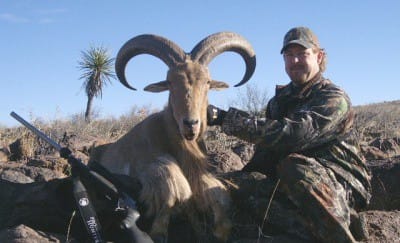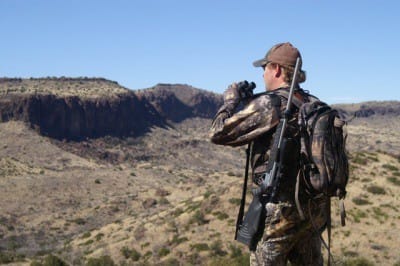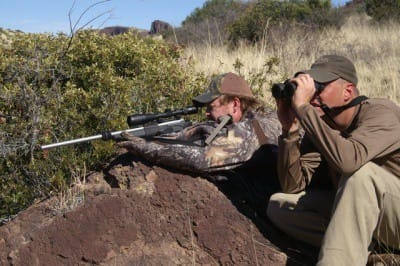
Thirty years ago my father gave me a book about all the big game animals of North America. I wore holes in the cover pouring over all the fascinating information it contained, and that book introduced me to the Barbary or Aoudad sheep. Though not a native North American animal, the book listed the Aoudad (pronounced “OW-dad”) because there was a huntable free-ranging population in the U.S., and the photos of these majestic sheep with long flowing beards and chaps made a lasting impression.
The Aoudad or Barbary sheep (Ammotragus lervia) is the only native wild sheep of northern Africa. “Barbary” is in reference to the countries of north Africa called the Barbary Coast, and Aoudad is the name used by the Berber tribe of the region for the animal. It seems that Aoudad is the name most widely used in the U.S.
Chad and the Atlas Mountains have been particular strongholds for Aoudads in Africa, and in 1957 introduction began in Texas. The sheep were released in many regions of the Lonestar State, but they have adapted especially well in the Palo Duro Canyon area in the Panhandle and the Davis, Glass and Chinati Mountains of the Trans-Pecos region in west Texas.
My Aoudad fascination was rekindled a few years back while turkey hunting at a ranch in the Hill Country. There was a life size mount of a big Aoudad ram being pulled down by a cougar, and I decided then and there that I wanted to hunt one of the magnificent creatures. I did not want to hunt Aoudad on a game ranch, but through a bit of investigation I found that opportunities to pursue them on free-ranging areas were available. As my research progressed, one name kept turning up. Hunter Ross and Desert Safaris (www.desertsafaris.com) had overwhelmingly positive feedback on The Hunting Report and other outfitter review websites, so I gave him a call.
Five minutes into our first conversation, I knew I was going to hunt with Ross as he was knowledgeable, enthusiastic, and he didn’t try to oversell his hunts. His prices were also fair and were in the ballpark of a good quality whitetail hunt. Hunter told me that he had access to over 140,000 acres in the Davis Mountains of west Texas that held Aoudad, but he warned that the terrain was quite rugged and that this would indeed be a real sheep hunt and not a walk in the park. I reserved the last week of February as my hunt dates because it did not conflict with any other big game hunting plans, and time couldn’t pass fast enough over the winter.
Finally I arrived at the remote ranch some 3 hours drive from the Midland/Odessa airport. The region close to Fort Davis is part of the Sonoran Desert, and the flats were covered in thornbrush, cacti and rocks. The Davis Mountains loomed in the distance, and they certainly looked like sheep country.

After checking the zero on my .300 Win. Mag T/C Pro Hunter, Ross explained the game plan for the following day. The ranch we were hunting was 104,000 acres, and we obviously could not cover much of it on foot. Hunter said we would drive as high as we could in his Jeep and then we would hike to vantage points or heads of canyons to glass areas where he had historically spotted sheep. Once we found our quarry, we would assess trophy quality, and then plan a stalk if warranted.
I asked Ross about trophy quality, and he shared that Aoudad rams are completely mature at 8 years, physically peak at 9 to 11 years, and anything over 28 inches of horn length is considered a trophy. Thirty inches is considered exceptional, and any ram 32 to 34 inches is a flat out monster. Desert Safaris average ram last year was 31 inches, and Hunter said that we would be looking for a good mature ram in the 30-inch plus range.
The next morning dawned cool and clear, and it took us more than 30 minutes in the Jeep to reach the mountainous interior of the ranch. As morning’s pink rays flooded the high desert, we hiked over the edge of a canyon to a vantage that allowed us to glass a couple thousand acres of the most rough but beautiful country I have ever seen. I had no idea such a place existed in Texas, and it took me a while to stop admiring the view and start glassing for sheep.
Our first two glassing sessions were fruitless, but as soon as we sat down at the third spot, we spied movement across the canyon about 3/4s of a mile away. Hunter said that it was a small band of Aoudad’s, and they crossed into another canyon over the ridge. We gathered our gear and headed their way, hoping that they stopped just out of site in a position where we could get a better look.
Some 25 minutes later, we eased into position to see the gentler slope where we hoped the sheep were feeding, and Hunter immediately spotted the group. There were five ewes, a lamb, a small ram and a big mature ram. I threw my Horn Hunter pack over a rock and got my rifle into position, but Ross told me to hang on. The sheep had no idea we were there, and at less than 100 yards, we could really study the big ram.
After some deliberation, Ross told me that he thought we should pass on the ram. He said, “He is a dandy, probably 29 inches, but it is the first day, I know what kind of rams are on this ranch, and I just think we can do better. If it were day four, I wouldn’t hesitate to have you shoot as he is definitely a mature trophy ram, but I think we can find a bigger one.” I have learned over the years to never try and guide the guide, so I eased the shell out of my Encore and pulled up my binos.
The Aoudad was one of the most majestic animals I have ever had the privilege of watching. There was a 20 mph cross wind, and his long beard and chaps blew wildly to one side as he watched over the small band of sheep. The little lamb stuck very close to the big ram which I found curious, and Hunter told me he was surprised that the big guy was even with such a group. “The rut is usually in September and October here, and that is when we see mixed herds. Generally by this time of year, mature rams are either in bachelor groups or solitary”, Ross explained.
After watching them for a while, one of the ewes finally saw us move, and the sheep headed up and over the far side of the canyon. I was amazed at how the big animals could traverse vertical rock faces with seemingly no effort, even the tiny lamb. The mature ram and the lamb were the last to depart, and they looked back at us in a classic sheep pose from the far skyline. That vivid image is burned into my memory for eternity.
We didn’t see any other sheep that day and only a couple of ewe groups and small rams on the second day, but after the exciting first encounter, my batteries stayed charged with anticipation. The wind was light and the air was crisp as we headed out of camp on the third morning. I had a good feeling deep inside, and I truly believed that our day had come.

As we made our way toward a large cliff line a couple of miles away, Hunter pointed out a natural spring in a small draw below. Though in desert country, Ross explained that this ranch has an unusual number of springs, and that is a key factor that contributes to the wealth of wildlife that thrives there including mule deer, pronghorn, javelina and Aoudad.
We hadn’t passed the spring by more than five minutes when Hunter grabbed my arm and yanked me to the ground. He quietly told me that as we topped a rolling hill, he spotted 3 sheep out on a flat. He had never seen Aoudad on that part of the ranch and figured they must have been headed back up high after coming to the spring to drink. We crawled up a few yards, and sure enough, I could make out three beautiful rams in my Nikon Premiere 10×42 binocular even though they were 500 yards away.
We were in a great position as there was a draw to our right that we could use as cover, and it looked as if it would get us within 200 to 250 yards of the sheep if they didn’t move off too quickly. They were slowly feeding, so we dropped down in the draw and hot-footed it up to what we estimated to be the closest we could get to the trio of rams.
When we again located the sheep, they were still in about the same spot, and there was a large rock and some brush about 15 yards in front of us over the slope. The brush gave us the cover to crawl up to the rock, and we got into position. Hunter said there were two huge rams and that I should shoot the one in the middle. As he ranged the sheep at 204 yards, I prepared for the shot. The morning sun was straight in my face and scope, and I had a tough time with the glare.
Finally I got into a position where I could see clearly, and I rested the crosshairs of my Nikon Monarch high on the middle sheep’s shoulder. Little did I know that the middle sheep and the one on the left had switched positions while I was dealing with the glare. I slowly squeezed the trigger of my Thompson Center .300 Win. Mag., and my sheep reared straight up on his hind legs. The 180 grain Winchester AccuBond did its job, and my Aoudad only went 30 yards before he was down and out.
Hunter slapped me on the back, and said, “Good shot buddy, but you shot the wrong sheep. Didn’t you see them switch places just before you shot?” My heart almost stopped as Hunter told me that he thought I still had a good ram, but the two bigger ones were 34 and 32 inches in his estimation.
I forgot all about inches when we got to my downed ram. He was a beautiful 8 ½ year-old ram with an incredibly long beard and leg chaps. We estimated him between 275 and 300 pounds, and I must say that I was in dumbfounded awe. Hunter said that this ram was better than he first thought and he dug into his pack for a tape. The fine ram stretched to a bit over 29 inches, but I didn’t care if he was 20 inches. He was gorgeous, he was mine, and I knew he was going to look fantastic on my wall.
I will likely never be able to hunt Stone’s or Bighorn sheep as their hunts’ price tags are simply out of my reach, but I did get to experience a wild sheep hunt for only a fraction of that cost. This hunt was all I had hoped it would be with rugged terrain, beautiful scenery and wary sheep. I may not have the pocket book for Dall’s or desert bighorn, but I can guarantee I will be back to hunt free-ranging Aoudad with Desert Safaris.
Aoudad Gear
Hunting Aoudad is definitely a sheep hunt, and quality gear is a must. Good optics are essential as lots of time will be spent glassing for sheep in the rugged mountain terrain. My Nikon Premiere LX 10×42’s worked great, and I had no eye fatigue after long glassing sessions.
Aoudad sheep are big and notoriously strong animals with mature rams weighing 275-350 pounds. I had heard of Aoudad’s soaking up two or three bullets before going down, and in rough terrain, I wanted to alleviate that situation if possible. I chose my trusty T/C Pro Hunter chambered in .300 Win mag and topped with a Nikon Monarch 4x12x40 scope. I used Winchester Supreme 180 grain AccuBond ammunition as it is flat shooting and accurate out of my T/C, and it has proven performance for me on big bodied mule deer and bull elk. The combination worked perfectly at just over 200 yards and my ram only made a short dash before piling up in the rocks.
Lastly, a good light pair of boots with good ankle support will make your sheep hunt more enjoyable. I work Cabela’s Silent Stalkers, and my feet and ankles stayed in great shape through the entire hunt.
Desert Safaris
For quality hunts in west Texas for Aoudad, mule deer and pronghorn, or bruiser Sonora Mexico mule deer, contact Hunter Ross and Desert Safaris www.desertsafaris.com at (210) 264-1745.Ross’s Aoudad hunts have been 90-100% successful since 2004 are priced quite fairly at $3,950 for four days. This price includes guide, great accommodations, three excellent meals a day and trophy preparation.



